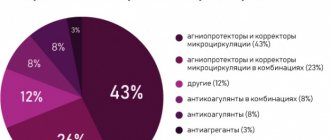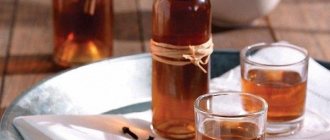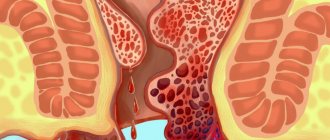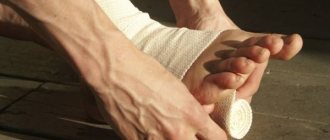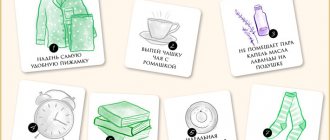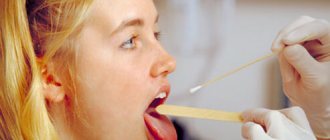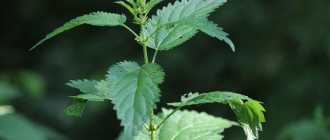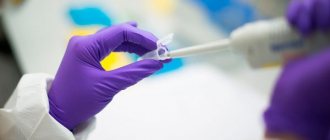Manifestation of varicose veins on the legs
The concept of varicose veins (varicose veins) in medicine refers to a long-term pathological process accompanied by expansion of the vein lumens. The valves, thanks to which the venous system “starts”, do not work fully, and the blood rises with difficulty.
This condition impedes the outflow of venous blood, which gradually accumulates in the leg area. There is a reverse outflow, stagnation, a dangerous painful condition is accompanied by unpleasant symptoms.
Many people, speaking about varicose veins on the legs, immediately imagine the following picture: the veins are dilated, swollen, and protrude upward on the surface of the body. The veins themselves have a bluish tint, from light blue to almost black. The legs hurt a lot, it’s hard to walk, the lower leg and foot swell, any movement of the lower limbs causes severe discomfort.
A similar picture is possible only in advanced stages of the pathology, and the initial manifestation of varicose veins is as follows:
- In the first stages of pathology development, patients observe cosmetic disturbances in the structure of the skin of the legs.
- The second stage of the disease is characterized by nighttime cramps; during the day, heaviness and fatigue of the legs are felt. The veins begin to burst and gradually appear blue.
- Over time, the lower legs and feet begin to swell, the skin becomes denser, and the subcutaneous tissue becomes covered with pigmentation.
- Ulcers form and tissue trophism is disrupted.
This condition is complemented by the following symptoms:
- telangiectasia develops - spider veins form;
- the veins expand, lengthen, gradually bend and bulge upward;
- Initially, excessive dryness of the skin of the legs appears, pigmentation gradually appears, dermatitis, eczema, and trophic ulcers begin.
This pathology provokes severe pain, and the more advanced the disease, the more frequent and severe the attacks of pain. Therefore, someone complains of throbbing pain when moving the limbs, slight aches, severe itching of the skin, night cramps, heaviness, and distension. Someone feels severe pain in the veins themselves. Unfortunately, the initial manifestations of varicose veins are very similar to the symptoms of other leg diseases, so it is often difficult to diagnose varicose veins at an earlier stage of development.
Note! Lack of treatment for varicose veins on the legs leads to the fact that by the age of 40 a person can become disabled.
Indications for use of horse chestnut
The effectiveness of treatment with herbal tinctures depends on the severity of the disease, duration of therapy and concomitant pathologies. It is worth remembering that chestnut components increase the synthesis of the protein antithrombin, which is responsible for the prevention of thrombosis and maintaining the fluid composition of the blood.
For people with hypocoagulation and a tendency to bleeding (patients with hemophilia or thrombocytopenia), this drug is strictly contraindicated.
The following conditions prevent treatment with chestnut:
- generalized and local inflammation of blood vessels (vasculitis);
- low blood pressure;
- children's age (up to 16 years);
- pregnancy (especially in the early stages) and breastfeeding;
- the presence of allergic reactions;
- blood thinning, tendency to bleeding;
- heart and kidney failure;
- the presence of hemorrhoids and a tendency to constipation.
In addition to allergic reactions (itching, burning, swelling), sudden bleeding also indicates intolerance to horse chestnut. With long-term use of chestnut-based tinctures and decoctions, there is a risk of nosebleeds, bleeding gums, and heavy and prolonged menstruation.
If a person has reduced thrombin synthesis, then in case of accidental cuts it becomes more difficult to stop the bleeding.
The biologically active substances of chestnuts increase vascular tone and fight congestion. When exposed to healthy cells of the body, the medicine activates their ability to regenerate.
The chestnut method of treatment, after completing the full course, provides the patient with varicose veins with relief from swelling, relief from pain and thinning of the blood, which allows the restoration of venous blood flow
.Herbalists recommend that all patients with varicose veins pay attention to horse chestnut to make the following amendments to their condition:
- Blood thinning.
- Reduced permeability of small vessels.
- Minimizing the likelihood of vein blockage.
- Increasing the speed of venous flow.
- Increased synthesis of antitrobin in the blood.
- Prevention of inflammatory processes and their treatment at the initial stage.
- Removing or reducing swelling.
- Increased vascular elasticity.
The healing effect of chestnut is not limited to the fight against varicose veins. The product, prepared at home, has a beneficial effect on the entire human cardiovascular system, preventing the formation of blood clots, lowering blood pressure, and strengthening capillaries.
The healing properties of horse chestnut for varicose veins
It is the medicinal properties of horse chestnut that even doctors immediately remember when it comes to the occurrence of varicose veins. The benefits of this plant for varicose veins have long been proven; treatment is considered fast and effective.
Externally, horse chestnut is a small shrub no more than 1.5 meters high or a huge tree up to 25 m in height. In the treatment of this disease, inflorescences are mainly used - white and pink candles, which have the greatest medicinal properties:
- the degree of swelling decreases;
- swelling subsides;
- the heaviness of the legs weakens, weakness and fatigue are felt less;
- the skin stops itching;
- the size and volume of the veins returns to normal, the veins themselves become elastic and dense;
- the general condition of the patient improves.
The medicinal properties of horse chestnut treatment are due to the fact that the plant is enriched with a large amount of vitamins, minerals, and tanning components. Particularly important substances are escin and esculin. Thanks to them, blood circulation improves and the formation of blood clots is prevented. Blood viscosity is normalized, and muscles become toned.
Contraindications
Before you start treating varicose veins with horse chestnut, you should make sure that there are no contraindications for use.
Chestnut is a plant classified as poisonous. There are few cases when drugs containing it are contraindicated, but there are times when horse chestnut drugs should not be used for varicose veins, namely:
- Low blood pressure.
- Pregnancy, breastfeeding.
- Various diseases of the gastrointestinal tract, including ulcerative ones.
- Constipation of unknown origin.
- Dysmenorrhea (menstrual cycle irregularities).
- Blood loss, including in internal organs.
- Blood viscosity is below normal, hemophilia.
- Presence of diabetes mellitus.
- Diagnosis of certain kidney diseases.
How to collect and prepare
Pharmacy chains offer us a large selection of dry horse chestnut preparations. However, if the plant grows in your area, it is quite possible to prepare it for future use yourself and use it in the treatment of varicose veins. Different parts of the plant can be used, the harvesting methods are slightly different.
- The collection of leaves and inflorescences begins in May, at the time when the tree or shrub begins to bloom profusely. The raw materials are washed under running water. Dry on paper or dry cloth, laying them out in a ventilated room, hiding from direct sunlight. Such drying can take a long time, so the raw materials need to be stirred daily to prevent them from becoming moldy.
- Horse chestnut kernels are harvested in the fall, just before the fruits become round and begin to ripen. Ripe kernels do not have a high content of medicinal components, so the kernels are collected in an unripe form. If you need to clear the kernels from the green peel, then remove it with a knife.
- The fruits of the plant are often used for treatment. They are selected in an already mature state. If necessary, grind it using a meat grinder or use it whole.
- The tree bark is removed at any time and crushed before drying.
Dry the kernels, bark and fruits in the same way as the leaves - in a dark place where it is warm and has good air circulation.
Important! If drying horse chestnut is done incorrectly, the plant will be useless during treatment - it will lose the main part of its medicinal components.
Chestnut-based ointments
Compresses are often used to treat varicose veins. They perfectly help relieve fatigue and pain in the lower extremities.
The recipe for preparing such a remedy is very simple: you need to take fresh chestnut flowers and grind them in a meat grinder. This porridge should be applied to the sore spot, covered with compress paper and left for one night.
In the morning, rinse it all off thoroughly with water. The water should be slightly cool.
The use of cellophane is not allowed, as diaper rash may form.
Compresses are usually used after the doctor's approval, but they do not pose a danger to humans. On the contrary, they help relieve swelling and inflammation.
Some people are prohibited from taking tinctures with alcohol, so there are recipes for special infusions. They are no less effective, according to reviews, and are just as simple and easy to prepare. Here are some effective recipes for traditional medicine infusions:
- You will need 1 crushed chestnut bark, half a liter of boiled chilled water. Mix all this and leave in a cool place for 8 hours. Strain and drink 30 ml three times a day.
- Mix 5 grams of crushed leaves and fruits with 0.2 liters of boiling water and cook in a water bath for half an hour. After that, strain and start taking a tablespoon once a day after meals. If hypersensitivity is not detected, the dose should be increased to 2-3 times a day.
Recipes for varicose veins
Considering that almost all parts of the plant are used for varicose veins, there are quite a lot of recipes for preparing medicines and compositions. First of all, these are all kinds of ointments, gels, tinctures, decoctions, baths, in general, everyone can choose something more suitable for themselves.
Alcohol tincture of inflorescences
Take 100 g of horse chestnut inflorescences, place them in a two-liter jar and fill them with a bottle of vodka. Leave in a dark place for half a month. Strain and store in the refrigerator. Take 25 drops orally daily after meals (3 times a day), the course of treatment is from 21 days to a month. If necessary, repeat after a week. This tincture can additionally be used to rub your feet when you feel heaviness, fatigue, discomfort and pain.
Decoction
Decoctions are prepared using the green peel of horse chestnut. Take a glass of peel, pour 1 liter of boiled water and cook after boiling for a quarter of an hour. Next, cover the container tightly and leave it to brew for a day. Strain. Take a tablespoon at night.
Decoctions are also prepared based on the leaves and fruits of the plant. Take a tablespoon of both and pour a glass of boiling water over it, like tea. Next, let it heat up in a water bath and simmer for 30 minutes. After cooling, filter, dilute to 0.2 liters, adding the required amount of boiling water and drink a tablespoon at night.
Horse chestnut ointment
Ointments prepared on the basis of horse chestnut are highly effective in the treatment of varicose veins.
- Grind 10 horse chestnut fruits into powder, add 10 tbsp. l. dry inflorescences. Add melted butter or lard in the amount of a tablespoon and simmer in a water bath for about 2 hours. The mixture is filtered until it cools. Store in a cool place.
- Taking fresh horse chestnut inflorescences and a tablespoon of sage, grind them using a blender, you should get about 2 tablespoons. Add a tablespoon of soft butter or vegetable oil. Simmer for about 3 hours in a water bath, filter and put in the refrigerator.
You can use ointments in the treatment of varicose veins together with other similar remedies, or you can do it yourself, rubbing it into your legs up to 4 times a day.
Compress
To make a compress on the legs, take 50 ml of alcohol tincture of horse chestnut, already prepared and infused. Dilute with a small amount of water and soak the fabric with the resulting liquid. Applying a cloth moistened with tincture to the desired area of the legs, wrap it in food grade cellophane. After a couple of hours, the compress is removed.
Horse chestnut kvass according to Bolotov
Kvass prepared from horse chestnut according to Bolotov has a general strengthening healing effect. The drink is prepared on the basis of water, nuts, sour cream, which can be replaced with whey, honey, sugar and the chestnut fruit itself. For fermentation, hop cones are added, raspberry leaves, black currant leaves are added for aroma.
Washed chestnut fruits in the amount of 40 pieces are crushed with a knife, after removing the peel, pour 3 liters of warm, unboiled water. Add a teaspoon of sour cream and a glass of granulated sugar. Add a couple of tablespoons of hops, a teaspoon of honey, 5 pieces of raspberry and currant leaves. Cover the container with kvass with a cloth and place it in a warm place; after about 14 days, the drink will be ready for use. Drink no more than a glass per day.
Note! Before using traditional methods, you need to make sure that the diagnosis is correct. Therefore, nothing like this should be used without prior consultation with a specialist!
Medicinal properties of chestnut
The excellent medicinal properties of horse chestnut are actively used by official medicine, using special medicines. Pharmaceutical companies produce ointment, gel, cream and tablets. Doses and options are determined by the doctor, including the drug in the regimen of therapy or preventive treatment. Most often, doctors use the following forms of drugs:
- aescusan (the drug in the form of a tincture consists of horse chestnut seeds and vitamin B1);
- Venitan gel or cream (a product based on escin contained in horse chestnut seeds);
- escisan tablets;
- rectactive (rectal suppositories made from horse chestnut fruit extract).
Cream and ointment are applied externally. The gel, in addition to external use, can be applied to the rectal mucosa for hemorrhoids. In any case, regardless of the form (gel, cream or tablets), the treatment regimen is prescribed by the doctor. Reviews confirm that proper use of the doctor-recommended treatment will help effectively prevent complications and alleviate the symptoms of the disease.
In most cases, traditional medicine is used as an additional method of treating varicose veins. It is important to foresee in advance how the tincture will affect the effect of conservative medicine drugs and whether this will cause an aggravation of existing pathologies.
Horse chestnut has the following effects:
- venotonic;
- blood thinner;
- hemostatic;
- anti-inflammatory;
- angioprotective;
- reparative action.
Chestnut-based preparations relieve swelling, normalize tissue nutrition, stimulate peripheral blood supply, dissolve blood clots, and enhance venous blood flow and lymphatic drainage.
Treatment of varicose veins with chestnut alcohol tincture
To prepare a tincture for oral administration, peel 100 grams of fruit and chop it. Place the resulting slurry in a glass jar, pour a glass of alcohol and leave for 2 weeks to infuse in the dark. Drink chestnut for varicose veins in alcohol three times a day, 30 drops, diluting with water.
Alcohol can be replaced with vodka. In this case, proceed similarly to the previous chestnut recipe for varicose veins, but increase the amount of vodka to a liter.
Alcohol tincture can also be used externally. According to the recipe for rubbing chestnuts against varicose veins, 100 grams of the fruit is poured with 300 milliliters of vodka and left for 14 days. The prepared tincture is rubbed onto the thighs, legs and ankles. You can also use the product as a compress. The duration of treatment for varicose veins with horse chestnut is a month. After 2 weeks, if necessary, therapy can be repeated. On our website you can find other recipes for chestnut fruit infusions, as well as read reviews about chestnut fruits.
Important!
You should not collect medicinal raw materials yourself. If the collection and drying rules are not followed, it will not have the desired effect. It is better to buy already prepared raw materials: prices for chestnut fruits are quite affordable.
